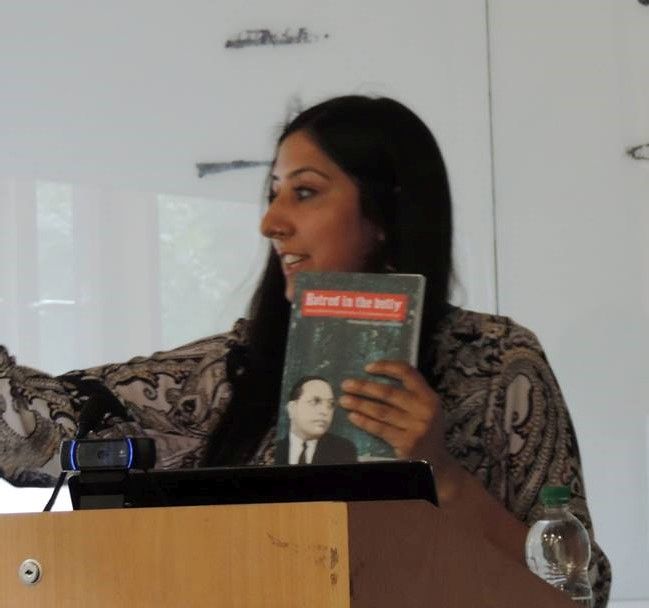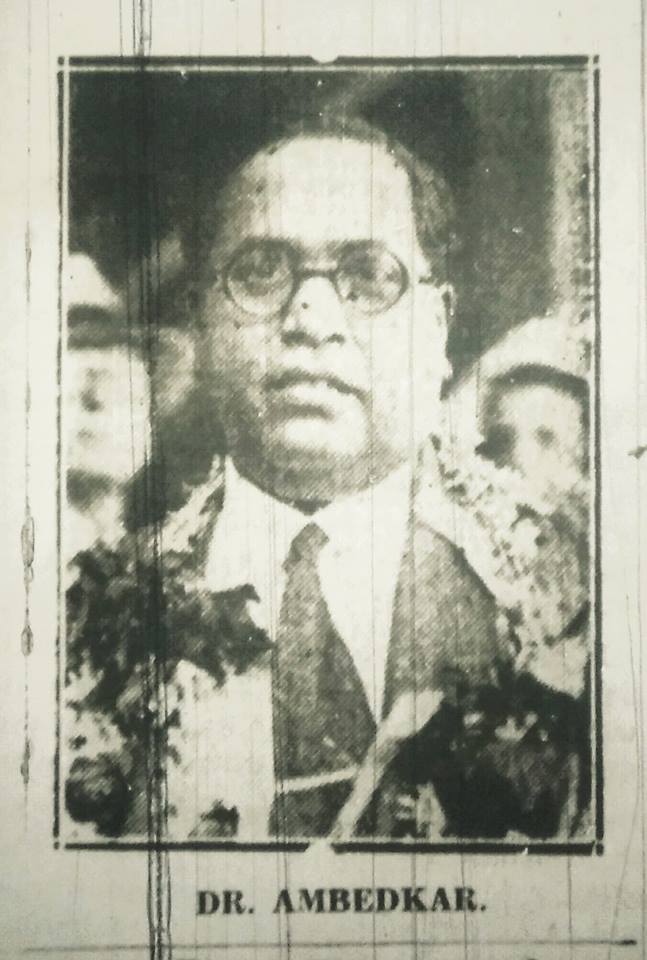Kavita Bhanot
[Excerpts from the talks given at SOAS and Manchester launch of Hatred in the belly: The politics behind the appropriation of Dr Ambedkar’s writings]
 For some years now, I’ve been thinking, talking about white supremacy, the ways in which it is present and normalised in every aspect of our lives in the UK, how as people of colour we can internalise it, reproduce it. It can be easy here in Britain to hide behind this struggle, to present yourself only as oppressed. It can be convenient not to think or talk about the ways in which you might be an oppressor as well, particularly if you are an upper caste South Asian – the active and subtle ways in which you’re complicit in the violence of caste, including through silence or ignorance. Often this ignorance is wilful because it is too difficult to look at ourselves with honesty, to question our own privilege and participation in a violent structure, we become defensive or fragile – this can be a form of silencing of those we oppress. I’m speaking today as someone who is on a journey of self-interrogation – I’m likely to reveal my own complicity again and again.
For some years now, I’ve been thinking, talking about white supremacy, the ways in which it is present and normalised in every aspect of our lives in the UK, how as people of colour we can internalise it, reproduce it. It can be easy here in Britain to hide behind this struggle, to present yourself only as oppressed. It can be convenient not to think or talk about the ways in which you might be an oppressor as well, particularly if you are an upper caste South Asian – the active and subtle ways in which you’re complicit in the violence of caste, including through silence or ignorance. Often this ignorance is wilful because it is too difficult to look at ourselves with honesty, to question our own privilege and participation in a violent structure, we become defensive or fragile – this can be a form of silencing of those we oppress. I’m speaking today as someone who is on a journey of self-interrogation – I’m likely to reveal my own complicity again and again.
We’re here today for the Manchester launch of Hatred in the Belly, the powerful response by a number of Dalit-Bahujan writers to the appropriation of Babasaheb Ambedkar’s writings by Arundhati Roy and Navayana Press through a newly introduced edition of Ambedkar’s Annihilation of Caste in 2014.
I think most of us are familiar with the idea of appropriation. Recently there was a debate around the issue, when Lionel Shriver rued, at the Brisbane Writers Festival, the threat that charges of appropriation pose to her ‘freedom of expression’; “I confess that this climate of scrutiny has got under my skin,” she said. “When I was first starting out as a novelist, I didn’t hesitate to write black characters, for example, or to avail myself of black dialects, for which, having grown up in the American South, I had a pretty good ear. I am now much more anxious about depicting characters of different races, and accents make me nervous.”
There was a great deal of criticism for her speech, for the arrogance and entitlement behind it, behind her indignation that she does not have the absolute right to write about who she wants, how she wants. Her indignation that she might be questioned for her representation of otherwise rarely represented communities, communities that rarely get similar platforms to represent themselves, representations that reveal her own unexamined biases and prejudices. It is partly due to social media giving a voice to so many who have been denied spaces in the mainstream that these conversations are now taking place, that such questions are being asked.
It was on similar terms that Roy’s introduction to Dr. Ambedkar’s Annhilation of Caste was critiqued when the extracts from the introduction, and later the book itself, were released. Annihilation of Caste is a speech written by Dr. Ambedkar in 1936, which he was not allowed to deliver since it was considered to be too radical. He published it himself and it has been printed, published, read online and offline ever since, in particular by dalit bahujans – it has been at the heart of anti-caste activism. Until recently, it has been largely ignored by upper castes. In 2014, an annotated introduced commercial edition was brought out in India and internationally, introduced by Arundhati Roy, published by Navayana and Verso Books here.
As we saw with Mohammed Ali’s recent demise, it is often easier to celebrate and at the same time ‘manage’ or ‘whitewash’ someone’s radicalism when they’re no longer around. The real question is how you respond or engage with the same radical critical resistance around you, when it seems to threaten your own privilege and freedom to say and do what you like. While this new edition was supposed to celebrate Ambedkar (through commodifying, packaging, distorting, silencing) the Ambedkars of today were ignored, mocked, dismissed. Instead of listening to, understanding, engaging with the critique, it was simply reduced by Roy and others to ‘identity politics’. There was an attempt to present critical voices as violent and intolerant. Complex layered various critiques were met by a rallying together of upper caste activists, writers, academics (the same upper castes who tend to see and criticise Lionel Shriver’s entitlement) in a vehement, even vicious defence of Roy’s ‘freedom of expression.’ Once more, we saw ‘freedom of speech’ discourse silencing critique and working to maintain an oppressive status quo.
The resistance to the commercialisation and appropriation of Ambedkar’s work by an upper caste publisher and an upper caste introducer was spontaneous; there were facebook posts, the popular YouTube Channel, Dalit Camera uploaded a series of interviews and critiques on Roy’s introduction, including an open letter to her. An online media portal dedicated to anti-caste voices, Round Table India (RTI) published a number of articles by a range of authors. Those who have devoted their lives to the annihilation of caste “from students to activists to lawyers to researchers to teachers to office workers to scientists to poets and writers…from across India, from Delhi to Kerala, Rajastan to Manipur and from across the diaspora, from London to the Bay Area.”
It is these diverse voices in these diverse forms that are brought together in Hatred in the Belly. Contrary to the misrepresentation of the critique as simply; ‘they say I can’t introduce the text because I’m not dalit’, we see a number of nuanced arguments, including a critique of the commodification of Ambedkar and his writings, of the damaging effects of an elite left and celebrity activism upon people’s movements and struggles, the colonial self-representation of Roy as simultaneously suddenly discovering caste and Ambedkar, and now being an expert on both – thus erasing and silencing an entire history of resistance and ongoing anti-caste struggle. There is the assertion that Roy is not introducing the text at all but is using Ambedkar’s writing simply to critique Gandhi, that she has written an introduction that is longer than the text itself, that there are errors in the representation of Ambedkar’s life and work. However, central to Hatred in the Belly and the wider campaign that it emerges from is indeed the important question of self- representation, of self-assertion. “We must shape our course ourselves and by ourselves,” said Babasaheb Ambedkar, quoted at the beginning of Hatred in the Belly.
Hatred in the Belly is about resisting an upper caste saviour or messiah: As Anoop Kumar writes: “I am merely resisting your messiah status now being thrust on us. Just for the simple reason that it is more difficult to dislodge a messiah, a mahatma, than to create one. We spent some seven decades and enormous efforts in dislodging one, thrust on us quite forcefully, by others who also were as persuasive as you are today in claiming that it was only in our best interests. But the truth was, as Babasaheb put it so poignantly in his discussion with Gandhi in 1931 “history tells that mahatmas like, fleeting phantoms, raise dust but raise no level.”
Hatred in the Belly is about laying open the ways in which upper castes, without a deep interrogation of internalised prejudices and supremacy, will constantly reveal and perpetuate brahmin supremacy, even while claiming to be anti-caste (revealed so clearly, not only in the publication and promotion of the Navayana edition of AOC but also the response to the critique). We will continue to reveal ourselves in this way as long as we continue to see caste as something that only exists outside of us. Hatred in Belly is about the need to ‘see’ that casteism is within us and all around us, the need to interrogate how we think, speak, act. It is about the need to own up to and dismantle inherited privilege, platforms, networks, along with wealth.
The book and the discussion around it brings layers and complexity to decolonial discourse in Britain, exposing structures and hegemonies of media, publication and academic discourse within India and how this plays out globally through international collaborations between ‘progressive’ elites. It is remarkable for the ways in which it bypasses powerful publishing, marketing and distribution structures and networks – emerging from a collective process of writing, editing, translating, publishing, marketing and distribution.
~~~
Kavita Bhanot is a writer, teacher, editor, particularly interested in the politics of reading and writing.










